Dated on Feb-15-2025


Professional installation and regular maintenance are essential for ensuring the optimal performance of threaded swivel joints. During installation, it's important to verify that threads are free from debris and properly aligned to prevent cross-threading, which can compromise the joint's integrity. Routine inspections should be conducted to detect any signs of wear or fatigue in the joints, allowing for timely replacements and reducing the risk of unexpected failures. Moreover, advancements in threaded swivel joint technology are continually enhancing their performance and application range. Innovations such as anti-friction coatings and advanced sealing mechanisms are being developed to further reduce wear and enhance the joint's ability to withstand extreme conditions. These technological improvements highlight the industry’s expertise and commitment to enhancing product life and system reliability. For those seeking authoritative sources on the subject, industry standards and guidelines often provide detailed information on the specifications and best practices for utilizing threaded swivel joints. Organizations like the American Petroleum Institute (API) and the International Organization for Standardization (ISO) set forth requirements that ensure products meet the rigorous demands of industrial applications. Adhering to these standards is essential for maintaining system integrity and safety. In conclusion, threaded swivel joints are indispensable for many industrial applications, offering a combination of flexibility, reliability, and durability. Their precision engineering, robust materials, and adherence to industry standards make them a trustworthy choice for demanding environments where failure is not an option. By understanding the benefits and requirements of these components, professionals can effectively leverage their capabilities to enhance system performance and ensure operational success.
Post time: Feb-15-2025
Prev:
Related PRODUCTS









